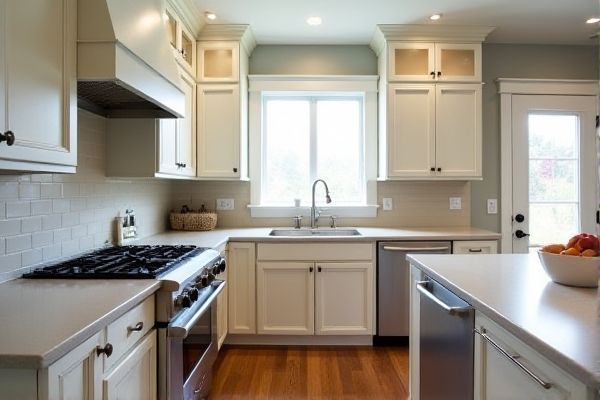
Apron trim adds a decorative edge around your sink or countertop, enhancing the aesthetic appeal and helping to conceal seams or gaps, while no apron trim offers a minimalist, seamless look for a clean and modern design. Explore the advantages and considerations of both options to decide which fits your style and functional needs.
Table of Comparison
| Feature | Apron Trim | No Apron Trim |
|---|---|---|
| Design | Includes a decorative border beneath cabinet doors or counters | Clean edge without additional decorative border |
| Appearance | Traditional, detailed look | Modern, minimalist look |
| Installation | Requires extra material and labor for trim attachment | Simpler, faster installation without extra parts |
| Cost | Higher due to additional materials and labor | Lower overall cost |
| Durability | Protects edges from damage, adds structural support | Edges more exposed, potentially less durable |
| Maintenance | May require more cleaning due to intricate detail | Easier to clean and maintain |
Understanding Apron Trim: Definition and Purpose
Apron trim is the horizontal molding located beneath a tabletop or countertop edge that enhances structural support and adds decorative detail. Without apron trim, furniture and cabinetry may lack reinforcement, potentially affecting durability and aesthetic appeal. Your choice between apron trim and no apron trim impacts both the stability and visual style of the piece.
No Apron Trim: A Minimalist Approach
No apron trim offers a minimalist approach, enhancing the sleek, modern look of your cabinetry by eliminating bulky framing beneath the countertop. This design choice maximizes legroom and provides a clean, uncluttered aesthetic ideal for contemporary kitchens or workspaces. Choosing no apron trim creates a streamlined appearance that highlights the materials and craftsmanship of your countertops and cabinets.
Key Differences Between Apron Trim and No Apron Trim
Apron trim is a decorative horizontal piece attached beneath kitchen or bathroom countertops, adding structural support and enhancing visual appeal, whereas areas without apron trim expose the raw edge of cabinetry or counter frameworks for a minimalist look. Apron trim often provides added protection against damage and hides seams or gaps, while no apron trim can simplify cleaning and create a sleeker, more modern aesthetic. Choosing between apron trim and no apron trim depends on balancing style preferences, durability needs, and maintenance considerations in interior design.
Aesthetic Impact: Enhancing Window and Door Frames
Apron trim significantly enhances window and door frames by adding a decorative element that defines and highlights architectural details, creating a polished and finished look. Without apron trim, frames may appear plain or incomplete, missing the visual depth and sophistication that trim provides. Selecting apron trim with complementary styles and proportions maximizes the aesthetic impact, ensuring frames harmonize with overall room design.
Functional Benefits of Apron Trim
Apron trim enhances the structural stability of your furniture by reinforcing the connection between legs and the tabletop, preventing wobbling and sagging over time. It also provides extra weight distribution, allowing your furniture to support heavier loads without compromising durability. Without apron trim, furniture may lack this additional support, increasing the risk of damage and reducing lifespan.
Challenges and Drawbacks: Apron Trim vs No Apron Trim
Apron trim adds complexity to countertop installation, requiring precise measurements and extra materials, which can increase costs and labor time. Without apron trim, countertops may have exposed edges that are more susceptible to damage and water infiltration, potentially reducing durability. You must weigh the aesthetic benefits of apron trim against the potential for higher maintenance and installation challenges.
Cost Considerations: Material and Installation
Apron trim increases the overall cost of a project due to additional materials like wood or MDF, which can range from $1 to $5 per linear foot depending on quality. Installation expenses are higher since apron trim requires precise cutting and fastening, potentially extending labor time by 30-50%. Skipping apron trim reduces both material and labor costs, making it a budget-friendly choice if minimalistic design suits Your space.
Design Compatibility: Which Style Suits Your Home?
Apron trim adds a classic, finished look that enhances traditional and farmhouse-style interiors, connecting your cabinetry to the surrounding walls with a defined frame. No apron trim suits modern and minimalist designs, offering clean, streamlined edges that emphasize simplicity and open space. Consider your home's architectural style and overall aesthetic to choose the option that best complements your design vision.
Maintenance and Durability Comparison
Apron trim enhances countertop edges by providing additional protection against chipping and wear, improving overall durability in high-traffic kitchen areas. Without apron trim, countertops might require more frequent maintenance due to exposed edges being vulnerable to damage from daily use and cleaning. The added layer created by apron trim reduces the need for repairs, making it a practical choice for long-term upkeep and durability.
Final Decision: Choosing the Right Finish for Your Space
Apron trim adds a classic, polished look to windows and doors, enhancing architectural detail and providing extra protection against wear and tear. No apron trim creates a clean, minimalist appearance that suits modern or industrial spaces, simplifying installation and maintenance. Your final decision should balance aesthetic preferences with functional needs, ensuring the finish complements your overall design while meeting durability requirements.
 homyna.com
homyna.com